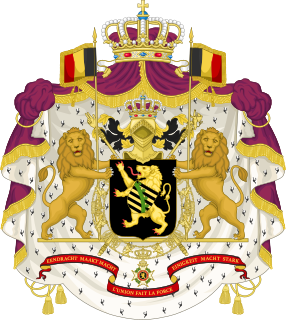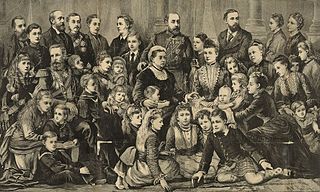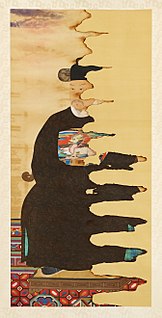
The House of Bonaparte is a former imperial and royal European dynasty of Italian (Genoese) origin. It was founded in 1804 by Napoleon I, the son of Genoese nobleman Carlo Buonaparte and Letizia. Napoleon was a French military leader who rose to power during the French Revolution and who, in 1804, transformed the First French Republic into the First French Empire, five years after his coup d'état of November 1799. Napoleon and the Grande Armée had to fight against every major European power and dominated continental Europe through a series of military victories during the Napoleonic Wars. He installed members of his family on the thrones of client states, expanding the power of the dynasty.

Prince of Wales is a title traditionally and ceremonially granted to the heir apparent of the British throne as a personal honour or dignity, and is not heritable, with it being merged with the Crown on accession to the throne. Since 1301, the title Earl of Chester has been given in conjunction with that of Prince of Wales. The Prince of Wales usually has other titles and honours, if the eldest son of the monarch; typically this means being Duke of Cornwall, which, unlike being Prince of Wales, inherently includes lands and constitutional and operational responsibilities. Since the 14th century, the title has been a dynastic title granted by the king or queen to the heir apparent to the English or British monarch, but the failure to be granted the title does not affect the rights to royal succession.

Mary of Teck was Queen of the United Kingdom and the British Dominions, and Empress of India, from 6 May 1910 until 29 January 1936 as the wife of King-Emperor George V.

Belgium is a constitutional, hereditary, and popular monarchy. The monarch is titled king or queen of the Belgians and serves as the country's head of state. There have been seven kings since independence in 1830.

Mary, Princess Royal and Countess of Harewood, was the only daughter of King George V and Queen Mary. She was the sister of Kings Edward VIII and George VI, and aunt of the current British monarch, Queen Elizabeth II. In the First World War, she performed charity work in support of servicemen and their families. She married Henry Lascelles, Viscount Lascelles, in 1922. Mary was given the title of Princess Royal in 1932. During the Second World War, she was Controller Commandant of the Auxiliary Territorial Service. The Princess Royal and the Earl of Harewood had two sons, George Lascelles, 7th Earl of Harewood, and The Honourable Gerald Lascelles.

The Chakri dynasty is the current reigning dynasty of the Kingdom of Thailand, the head of the house is the king, who is head of state. The family has ruled Thailand since the founding of the Rattanakosin Era and the city of Bangkok in 1782; following the end of Taksin Thonburi's reign, when the capital of Siam shifted to Bangkok. The royal house was founded by Rama I, an Ayutthaya military leader of Sino-Mon descent.

The Hashemites, also House of Hashim, are the royal family of Jordan, which they have ruled since 1921, and were the royal family of the kingdoms of Hejaz (1916–1925), Syria (1920) and Iraq (1921–1958). The family had ruled the city of Mecca continuously from the 10th century, frequently as vassals of outside powers, and were given the thrones of the Hejaz, Syria, Iraq and Jordan following their World War I alliance with the British Empire; this arrangement became known as the "Sharifian solution".
An heir apparent is a person who is first in an order of succession and cannot be displaced from inheriting by the birth of another person. An heir presumptive, by contrast, is someone who is first in line to inherit a title but who can be displaced by the birth of a more eligible heir.

A crown prince or hereditary prince is the heir apparent to the throne in a royal or imperial monarchy. The female form of the title is crown princess, which may refer either to an heiress apparent or, especially in earlier times, to the wife of the person styled crown prince.

Princess Victoria Alice Elizabeth Julia Marie of Battenberg was the mother of Prince Philip, Duke of Edinburgh, and mother-in-law of Queen Elizabeth II.
Royal Highness is a style used to address or refer to some members of royal families, usually princes or princesses. Monarchs and their consorts are usually styled Majesty.

Prince of the United Kingdom of Great Britain and Northern Ireland is a royal title normally granted to sons and grandsons of reigning and past British monarchs. The title is granted by the reigning monarch, who is the fount of all honours, through the issuing of letters patent as an expression of the royal will.
Infante, also anglicised as Infant or translated as Prince, is the title and rank given in the Iberian kingdoms of Spain and Portugal to the sons and daughters (infantas) of the king, regardless of age, sometimes with the exception of the heir apparent or heir presumptive to the throne, who usually bears a unique princely or ducal title. A woman married to a male infante was accorded the title of infanta if the marriage was dynastically approved, although since 1987 this is no longer automatically the case in Spain. Husbands of born infantas did not obtain the title of infante through marriage, although they were occasionally elevated to the title de gracia at the sovereign's command.

Tharrawaddy Min was the 8th king of the Konbaung Dynasty of Burma. He repudiated the Treaty of Yandabo and almost went to war with the British.

Isetnofret was one of the Great Royal Wives of Pharaoh Ramesses II and was the mother of his heir, Merneptah. She was one of the most prominent of the royal wives, along with Nefertari, and was the chief queen after Nefertari's death.

Field Marshal Chakrabongse Bhuvanath, the Prince of Bishnulok, was the 40th child of King Chulalongkorn and the fourth child of Queen Sri Bajarindra.

Queen Victoria, the British monarch from 1837 to 1901, and Prince Albert had 9 children, 42 grandchildren, and 87 great-grandchildren.

Wonjong of Joseon or Prince Jeongwon was a prince during the Joseon dynasty. He was a son by a concubine to the Joseon dynasty's 14th monarch, king Seonjo, and half brother of king Gwanghaegun and father of king Injo. His birth name was Yi Bu.













